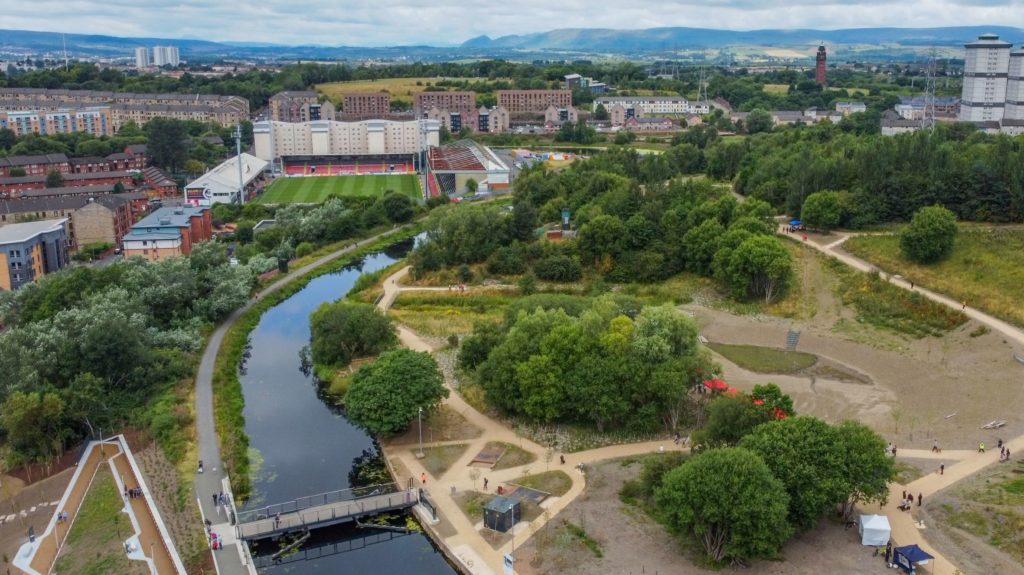The solution
Pre-planning for the works commenced late 2018 with LUC developing the master plan spanning an area of 17 hectares. General site clearance to allow for the construction works started in February 2019 with the first stages of the project – the construction of a sliding pedestrian bridge starting in August 2019.
Design and build sliding pedestrian bridge
Garscube Bridge was built by Mackenzie Construction following design collaboration between Scottish Canals and Mackenzie Construction who were supported by Mayflower Engineering, Allen Gordon Civil Engineers, and Fairfield Control Systems. A preliminary proposal was prepared by LDN Architects, LUC and David Narro Associates.
The large construction project required coordination with boat users and the general public on this busy section of an inner city stretch of canal. Construction started with a 6m deep cofferdam with built in balance pipes to maintain existing water flows which were critical to maintain water levels within the canal network.
Mackenzie Construction coordinated and installed the new infrastructure for the bridge which had to be transported from Applecross Street over 1.5km away. A reinforced concrete foundation and supporting pillars were cased in-situ with 115m3 of concrete poured to form the 600mm thick continuous slab. The bridge decks were built off site and lifted into position. The bridge has sliding decks that can be operated and monitored remotely to allow boats to pass with new approach paths and a wide level deck to promote access for all. The Garscube Bridge is linked via a 750m long path, to the Panmure Gate. The Panmure Gate, also constructed during the project is an elevated metal walkway and a 100m long timber boardwalk. The new bridge and link will provide residents with access to nature within the city and the sustainable transport network along the canal.
Environmental protection and habitat improvements
Mackenzie Construction carried out zonal working to ensure there was no contamination from invasive species throughout the site and throughout the project the removal of existing habitats was minimised wherever possible. To improve habitats for local birds and wildlife, a 30,000m2 wildflower meadow was planted along with 700 trees and 1500 saplings.
High quality hard landscaping
New entrance ways and pathways created to Sustrans standard were introduced to the area to promote active travel for walkers, wheelers and cyclists. This links the Claypits to the towpath network and the wider National Cycle Network. Various structures to promote active travel and leisure activities such as fishing were also constructed including boardwalks, floating pontoons and raised metal gantries and bridges. Disabled access fishing pegs were also installed to promote access for all.
Coordination and installation of multi-service utilities
There were utility services installed throughout the site to allow for future development of leisure facilities and to support Scottish Canals ‘Living on Water’ initiative. This aims to provide high-quality moorings to encourage more people to live on the water and create waterside communities.
Foul, surface and land drainage
This project was run concurrently alongside other canal regeneration projects and sections of the canal in this area were integrated into the North Glasgow Integrated Water Management System – Glasgow’s Smart Canal. This drainage system is alerted in advance of heavy rainfall and the canal is automatically lowered to prevent risk of flooding.
New swales and urban SUDS were also installed throughout the site.
Canal wall repairs
Throughout the project there were numerous areas along the canal that saw embankment and wall repairs to further accommodate living on water and dredging activities.

